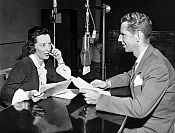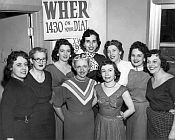WOMEN WHO CONQUERED RADIO'S GLASS CEILING
By John F. Schneider, 2020
|
|
WOMEN WHO CONQUERED RADIO'S GLASS CEILING By John F. Schneider, 2020
|
|
www.theradiohistorian.org Copyright 2020 - John F. Schneider & Associates, LLC (Click on photos to enlarge) In
radio's infancy, women were commonly heard on the air as program hosts.
In 1922, Jesse Koewing was one of the first announcers at WOR in Newark (later New York City). She identified herself on the air with just her initials, "J. E. K."   WHER in Memphis was the first
of several radio stations to adopt an “all-woman” format during the
disc jockey era.In 1955, Sam Phillips (of Sun
Records fame) opened the station in 1955, and His wife Becky was one of
the first DJ’s. WHER broadcast until
1973. Other stations that tried all-girl
formats included WNEW-FM in New York, KNIT in Abilene, Texas, WSDM in
Chicago,and CHIC in Toronto.
|
|
Before the dawn of broadcasting,
women
were frequently hired
as wireless operators. And so it was not
a surprise that women’s voices were heard as announcers and program
hosts in
the early days of broadcast radio. Sybil
Herrold was perhaps the world’s first disc jockey - she played Victrola
records
on her husband Charles Herrold’s experimental station, which broadcast
in San
Jose from 1912 to 1917. In Boston,
Eunice Randall’s voice was heard on a wide variety of programs over
AMRAD
station 1XE (which became WGI in 1922). In
New York City, WOR audiences regularly heard Jesse
Koewing, who was
identified on the air only as “J.E.K.”, while Betty Lutz was the
popular
“hostess” heard on WEAF. At
WAHG (now WCBS), 16-year-old Nancy Clancey
was billed as the country’s youngest announcer. Additionally, women were
frequently
hired as “program managers”,
responsible for booking the live entertainment that filled their
stations’
airwaves, and they often came before the microphone to introduce the
entertainers But, by the start of the network
era in
the mid 1920’s,
there became to be a prejudice against hearing women’s’ voices on the
radio. "Flat"
or "Shrill" Broadcasters complained that the
tone quality of early receivers and speakers made women’s
higher-pitched voices
sound shrill and dissonant. But this prejudice remained even as higher
fidelity
receivers became available in the early 1930’s. The conventional wisdom
was
that "audiences don't like or trust women as announcers" and
"only male voices can speak with authority." An audience survey conducted by
WJZ in
1926,
with 5,000 respondents, determined that listeners of both sexes
preferred the
male voice by a margin of 100 to 1. In 1934, an article in the Journal
of
Social Psychology concluded that “the male voice is more natural,
more
persuasive, and more likely to arouse interest over the air than the
feminine
voice.” In 1935,
Cantril
and Gordon
Allport published “The Psychology of Radio, and determined that 95%
preferred
hearing male voices over the radio. This prejudice against female
announcers was also expressed
by station managers of the day. In a letter to the editor in Radio
Broadcasting Magazine, a station director wrote, “ … for
announcing, a
well-modulated male voice is the most pleasing to listen to. I have nothing against a woman’s announcing,
but really do believe that unless a woman has the qualifications known
as
“showman’s instinct”, it really does become monotonous.”
Another station executive from
Pittsburgh wrote,
“I would permit few women lecturers to appear [on the radio]. Their voices do not carry the appeal, and so
whatever the effect desired, it is lost on the radio audience. Their voices are flat or they are shrill, and
they are usually pitched far too high to be modulated correctly.” As a result, by 1930 women’s
voices had
virtually disappeared
from the airwaves, except for mid-afternoon programs aimed at the
housewife and
discussing such banal topics as cooking, fashion and beauty tips. This was especially true in
network
radio, with rare
exceptions. In a notable experiment, NBC
hired the vaudeville comedienne Elsie Janis in 1934 to be the network’s
first
female announcer, joining a staff of 26 men. But
when listeners complained that a woman's voice was
inappropriate for
serious announcing work, an NBC executive commented that they were "not
quite sure what type of program her hoarse voice is best suited for,
but it is
certain she will read no more press news bulletins.”
Janis was relegated to announcing the weather
and variety shows, and seems to have left NBC within a year. Over at CBS, they paired radio
actress
Bernardine Flynn with Durward Kirby to host a daily newscast. But Kirby was assigned to read the “hard”
news stories while Flynn reported only the “human interest” items. Perhaps the only woman to break the taboo on women reporting serious news stories during the network era was Mary Margaret McBride. She began her radio career on WOR in New York in 1934, taking the air name Martha Deane and playing a grandmotherly-type woman who dispensed philosophy and common sense. In 1937, she moved over to the CBS network under her own name, and became recognized for her interviewing capabilities. Her daily afternoon program included high-level politicians, generals, and movie stars. She moved to NBC in 1941, where her daily audience numbered in the millions. She remained a regular feature on network radio until 1960, and then continued in syndication. War
Years World War II temporarily opened
employment opportunities for
women in radio, as the male staffs of the networks and local stations
were
siphoned off by the armed services. Women
assumed the roles of announcers and newscasters,
studio engineers,
and sound effects specialists. In 1943,
NBC hired ten young “pagettes” to supplement its depleted staff of
Radio City
pages. Around the country, women were also hired as advertising sales
persons,
program directors, traffic managers, continuity directors, and even
station
managers. But sadly, just as occurred in
manufacturing plants, when the men returned home after the war the jobs
reverted
to men who “had to support their families”, and the women were told to
go home
and be happy homemakers. In the 1950’s, as the radio industry adapted to the new competition from television, many radio announcers turned into disc jockeys, but the prejudice against female voices on the radio continued. The big-name deejays at local stations around the country were all men. But there were a few exceptions. In 1955, Sam Phillips (of Sun Records fame) opened WHER in Memphis. Phillips enjoyed hearing women’s voices on the air, and he hired an all-female staff to run the station. WHER operated from studios in a Holiday Inn motel, and this led to a spinoff program, sponsored by Holiday Inn – WHER personality Dottie Abbott, taking the air name Dolly Holiday, hosted an overnight program of easy listening music syndicated to stations around the country. Her soothing voice and soft music could be heard across the AM band after midnight almost anywhere in the country into the early 70’s. Changing
Times In the late 1960’s, WNEW-FM in New
York
City experimented
with an all-female format. Allison
Steele won an audition against 800 other women and began working there
as a
disc jockey. She stayed on when the
format was abandoned 18 months later, and gained popularity as “The
Nightbird”. Her overnight show drew an
estimated
audience of 78,000, and she was chosen by Billboard Magazine in 1976 as
the “FM
Personality of the Year.” As the 1970’s progressed, the barriers against hearing women on the air gradually faded away. CHIC in Toronto and KNIT in Abilene, Texas, both had all-girl deejay staffs, although the newscasts continued to be voiced by men. An all-woman format was also tried at WSDM in Chicago, where Yvonne Daniels sharpened her chops before moving on to the AM powerhouse WLS in 1973. Also in Chicago, Connie Czersin debuted on WIND in 1974. Maxanne Sartori played progressive rock at KOL-FM in Seattle before moving to Boston to take the afternoon slot at WBCN-FM. Donna Halper played the hits at WMMS in Cleveland, where she was credited with discovering the rock band Rush in 1974. Liz Kiley started her career at WLAV in Grand Rapids in 1976, and within three years had moved up the ranks to WABC in New York. Today, perhaps a third of the
voices on
radio and television are female, and few people think anything of
it. Women newscasters are now heard on local radio and TV
stations, and even anchor the nightly network prime-time
telecasts. The women in broadcasting today owe a huge vote of
thanks to the above-mentioned women, as well as the dozens of others
who helped them break through broadcasting's "glass ceiling".
This article
originally appeared in the July 22, 2020, issue of RADIO WORLD REFERENCES: Women and
Radio: Airing Differences, edited by Caroline
Mitchell Fireside
Politics: Radio and Political Culture in the United States, 1920-1940, by Douglas B. Craig “Remembering
the Ladies—A Salute to the Women of Early Radio”, by Donna L. Halper,
“Popular
Communications”, January 1999 “Broadcasting
Magazine”, July 1, 1934 “The Story of
WHER, America’s Pioneering, First All-Woman Radio Station (1955)”, www.openculture.com “Dolly
Holiday - A Dreamy Soothing Voice in
the Night”, www.rumormillnews “Mary
Margaret McBride, AMERICAN JOURNALIST AND BROADCASTER”, By The
Editors of Encyclopaedia Britannica Wikipedia:
“History of Radio Disc Jockeys”
|